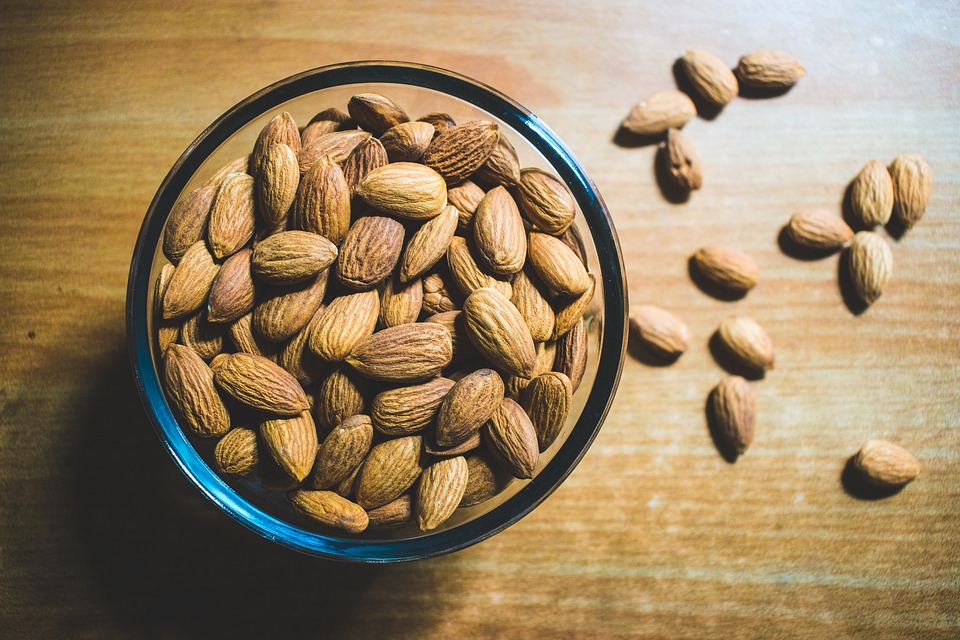
Almonds, a highly nutritious nut, have been a part of human diets for centuries. Known for their versatile use and health benefits, these nuts are not just a culinary delight but a nutritional powerhouse. This comprehensive guide explores the intricate nutritional profile of almonds per 100 grams, highlighting not only their macronutrients but also the specific types of proteins, fats, carbohydrates, and fibers they contain, as well as an array of other essential nutrients.
Table 1: Nutritional Profile of Almonds (Per 100g)
| Nutrient | Amount in 100g |
|---|---|
| Calories | 579 kcal |
| Protein | 21 g |
| Total Fat | 50 g |
| Saturated Fat | 3.8 g |
| Monounsaturated Fat | 31 g |
| Polyunsaturated Fat | 12 g |
| Carbohydrates | 22 g |
| Fiber | 12.5 g |
| Sugars | 4.8 g |
| Vitamin E | 26 mg |
| Magnesium | 268 mg |
| Calcium | 264 mg |
| Iron | 3.7 mg |
Detailed Nutritional Composition of Almonds (Per 100g)
Almonds stand out for their impressive nutrient density, providing a range of health benefits in just a small serving.
Caloric and Macronutrient Profile
- Calories: 100 grams of almonds pack approximately 579 calories, providing a substantial energy boost.
- Protein: They offer about 21 grams of protein, predominantly made up of essential amino acids like arginine, which is known for its benefits to heart health and immune function.
- Carbohydrates: Containing about 22 grams of carbohydrates, almonds have a lower carb content compared to other nuts, with a minimal impact on blood sugar levels. Their sugar content is low, at 4.8 grams, primarily composed of natural sugars like fructose.
- Fats: The fat content in almonds is about 50 grams, primarily healthy monounsaturated fats, which are beneficial for heart health. They also contain polyunsaturated fats, including omega-6 fatty acids, crucial for brain health and metabolism.
Fiber Content and Types
- Dietary Fiber: Almonds are an excellent source of dietary fiber, with 12.5 grams per 100 grams. This includes both soluble and insoluble fibers. Soluble fiber helps in regulating blood sugar levels and lowering cholesterol, while insoluble fiber aids in digestive health.
Vitamins and Minerals in Almonds
Almonds are a rich source of several vitamins and minerals, each playing a unique role in maintaining health.
- Vitamin E: With their high Vitamin E content, almonds are great for skin health and have antioxidant properties that protect cells from oxidative damage.
- Magnesium: They are a significant source of magnesium, which is crucial for over 300 enzymatic reactions in the body, including energy production and nervous system regulation.
- Calcium and Phosphorus: These minerals work in tandem to strengthen bones and teeth.
- Iron: Essential for hemoglobin formation, iron in almonds aids in oxygen transport and energy metabolism.
Additional Nutrients and Antioxidants
- Trace Elements: Almonds contain trace elements like zinc and selenium, which are vital for immune function and thyroid health.
- Phytonutrients: They are rich in phytonutrients like flavonoids and phenolic acids, which have anti-inflammatory and antioxidant properties.
Health Benefits of Regular Almond Consumption
Incorporating almonds into your diet can have numerous health benefits:
- Heart Health: The unsaturated fats, fiber, and antioxidants in almonds contribute to heart health by reducing blood pressure and cholesterol levels.
- Weight Management: High in protein and fiber, almonds promote satiety, helping in weight management.
- Blood Sugar Control: Their low glycemic index makes them beneficial for blood sugar control, especially in people with diabetes.
- Gut Health: The fiber in almonds feeds beneficial gut bacteria, aiding in digestive health.
Considerations for Different Forms of Almonds
Soaked Almonds
- Soaking almonds can make certain nutrients more bioavailable and improve digestibility. The process of soaking may slightly alter their nutrient composition, mainly reducing phytic acid, which can inhibit mineral absorption.
Almond Flour and Almond Milk
- Almond Flour: It retains most of the nutrients found in whole almonds but has a reduced fiber content.
- Almond Milk: Commercial almond milk is often fortified with vitamins and minerals but can be lower in protein and fiber compared to whole almonds.
In conclusion, almonds in their various forms offer a wealth of nutrients. Understanding their detailed nutritional profile can help in maximizing their health benefits, whether consumed as a snack, in almond flour recipes, or as almond milk in your favorite beverages.
Table 2: Calorie Content in Different Forms and Portions of Almonds
| Almond Product/Portion Size | Calories |
|---|---|
| 1 Raw Almond | 7 kcal |
| 25 Raw Almonds | 164 kcal |
| 1/4 Cup of Almonds | 207 kcal |
| 1 Cup of Almond Flour | 640 kcal |
| 1 Cup of Almond Milk | 30-50 kcal (varies by brand and type) |
| 100g Almond Butter | 614 kcal |
| 100g Almond Milk | 17 kcal |
Exploring Almonds Beyond Basic Nutrition
Almonds are much more than just a source of essential nutrients. Their diverse range of bioactive components and health-promoting properties make them a superfood in the truest sense.
Impact on Metabolic Health
- Reducing Inflammation: The antioxidants in almonds, especially Vitamin E and flavonoids, play a significant role in reducing inflammation in the body, which is a key factor in chronic diseases.
- Heart Health: Regular consumption of almonds has been linked to improved heart health. The monounsaturated fats help in reducing LDL (bad) cholesterol levels and increasing HDL (good) cholesterol levels, thereby reducing the risk of heart diseases.
- Blood Sugar Regulation: The low glycemic index and the presence of magnesium in almonds aid in better blood sugar control, making them an ideal snack for people with diabetes or those at risk.
Nutritional Variants in Different Types of Almonds
Raw vs. Roasted Almonds
- Raw Almonds: They retain all their natural nutrients but contain phytic acid, which can bind with minerals and reduce their absorption.
- Roasted Almonds: Roasting can enhance flavor and crunchiness but may slightly reduce some heat-sensitive nutrients like Vitamin E.
Soaked Almonds
- Nutrient Bioavailability: Soaking almonds overnight can reduce phytic acid levels, making it easier for the body to absorb the nutrients.
- Easier Digestion: Soaked almonds are easier to digest, as the soaking process breaks down the gluten in almonds, making them gentler on the stomach.
Table 3: Macronutrient Comparison in Different Almond Products (Per 100g)
| Nutrient/Product | Almonds (Raw) | Almond Butter | Almond Milk (Unsweetened) | Almond Flour |
|---|---|---|---|---|
| Calories | 579 kcal | 614 kcal | 17 kcal | 640 kcal |
| Protein | 21 g | 21 g | 1 g | 24 g |
| Total Fat | 50 g | 56 g | 1.5 g | 56 g |
| Carbohydrates | 22 g | 20 g | 1 g | 20 g |
| Fiber | 12.5 g | 10 g | 0.5 g | 11 g |
| Sugars | 4.8 g | 4 g | 0.3 g | 4 g |
Almond Products and Their Nutritional Aspects
Almond Butter
- Nutrient-Dense: Almond butter retains most of the nutrients found in whole almonds, including healthy fats, proteins, vitamins, and minerals. However, it is calorie-dense, so moderation is key.
Almond Oil
- Healthy Fats: Rich in monounsaturated fats, almond oil is excellent for heart health and can be used for cooking or as a salad dressing.
Almond Milk
- Low-Calorie Alternative: Almond milk is a low-calorie, dairy-free alternative, often fortified with additional vitamins and minerals. It’s a great option for those who are lactose intolerant or following a vegan diet.
Serving Sizes and Recommendations
Moderation is key when it comes to including almonds in your diet, due to their high-calorie content. A standard serving size is typically around 23 almonds (about 28 grams), which provides a good balance of nutrients without overindulging in calories.
Incorporating Almonds into Your Diet
Almonds can be incorporated into your diet in various forms:
- Snacking: A handful of almonds can be a healthy and satisfying snack.
- In Cooking: They can be used in both sweet and savory dishes, adding a nutty flavor and crunch.
- Almond Flour: A great gluten-free alternative to regular flour in baking.
- Almond Milk: Can be used in cereals, smoothies, or as a dairy substitute in coffee and tea.
Almond Varieties and Their Nutritional Differences
Comparing Nutrient Profiles: California vs. Mamra Almonds
- California Almonds: Typically larger, they are known for their versatility in cooking and baking. They contain about 579 calories per 100g, with a high content of Vitamin E and magnesium.
- Mamra Almonds: Often praised for their superior quality, Mamra almonds are smaller, crunchier, and have a richer flavor. Nutritionally, they are denser, with higher concentrations of healthy fats and proteins.
Green Almonds: A Unique Nutritional Treat
- Nutritional Content: Green almonds are a delicacy and are consumed whole when the nut is still soft. They are packed with antioxidants and are a good source of dietary fiber and protein. They contain vitamins C and E, and are lower in calories compared to mature almonds.
Almonds in Specialized Diets
Almonds in a Keto Diet
- Macro Breakdown for Keto: In a ketogenic diet, almonds are beneficial due to their high-fat (about 50g per 100g), moderate-protein (about 21g per 100g), and low-carbohydrate (about 22g per 100g) content. They are ideal for maintaining ketosis.
Incorporating Almonds in Vegan and Gluten-Free Diets
- Plant-Based Nutrient Source: Almonds provide essential nutrients that might be harder to come by in a vegan diet, such as iron and protein.
- Gluten-Free Baking: Almond flour is a staple in gluten-free baking, offering a nutritious and tasty alternative to wheat flour.
Table 4: Vitamins and Minerals in Almonds (Per 100g)
| Vitamin/Mineral | Amount in Almonds |
|---|---|
| Vitamin E | 26 mg |
| Magnesium | 268 mg |
| Calcium | 264 mg |
| Iron | 3.7 mg |
| Potassium | 733 mg |
| Zinc | 3.1 mg |
| Phosphorus | 481 mg |
| Riboflavin (B2) | 1.1 mg |
Glycemic Index Impact and Portion Sizes of Almonds
Almonds are not only celebrated for their rich nutrient profile but also for their favorable impact on blood sugar levels, largely due to their low glycemic index (GI). Understanding the GI impact and appropriate portion sizes of almonds can help in effectively incorporating them into a balanced diet, especially for individuals managing blood sugar levels.
Glycemic Index of Almonds
Impact on Blood Sugar
- Low Glycemic Index: Almonds have a low GI, meaning they have a minimal impact on blood sugar levels when consumed. This is due to their high fiber content and healthy fats, which slow down the digestion and absorption of carbohydrates.
- Benefits for Diabetics: For individuals with diabetes, incorporating low GI foods like almonds into the diet can help in better blood sugar management. The slow release of glucose into the bloodstream aids in maintaining steady blood sugar levels.
Combining with Other Foods
- Balancing Meals: Adding almonds to meals that contain higher GI foods can help in reducing the overall glycemic impact of the meal. For example, pairing almonds with a piece of fruit can balance out the fruit’s natural sugars.
Understanding Portion Sizes
Recommended Servings
- Standard Serving Size: A typical serving size of almonds is about 23 nuts, which equates to roughly 1 ounce (28 grams). This serving size contains about 164 calories, 6 grams of protein, 14 grams of fat, and 3.5 grams of fiber.
- Caloric Density: While almonds are nutrient-dense, they are also high in calories due to their fat content. Therefore, it’s important to be mindful of portion sizes, especially for those watching their calorie intake.
Practical Tips for Portion Control
- Measuring Portions: Using measuring cups or a food scale can help in accurately determining serving sizes. For a quick estimate, a handful of almonds is roughly equivalent to one serving.
- Incorporation in Meals: Sprinkling chopped almonds over salads, oatmeal, or yogurt is a great way to enjoy their benefits without overdoing the portion size.
Incorporating Almonds into a Diabetic Diet
As a Snack
- Healthy Snacking Option: For people with diabetes, almonds are an excellent snack choice. They provide sustained energy without causing significant spikes in blood sugar levels.
In Cooking and Baking
- Versatile Use: Almonds can be used in various forms – whole, sliced, or as almond flour – in cooking and baking, adding texture, flavor, and nutritional value to meals.
The low glycemic index of almonds makes them an excellent food choice for maintaining stable blood sugar levels, while their rich nutrient profile adds substantial health benefits. Being mindful of portion sizes ensures that one can enjoy these benefits without consuming excess calories. For individuals with diabetes or those mindful of their blood sugar levels, almonds can be a valuable addition to their dietary regimen.
Targeted Health Benefits of Almonds
Cognitive and Brain Health
- Nutrients for the Brain: Almonds are a source of nutrients like omega-3 fatty acids and vitamin E, which have been linked to improved brain health and a lower risk of cognitive decline.
Skin Nourishment from Almonds
- Skin Care Benefits: The vitamin E and antioxidants in almonds can protect the skin from damage caused by free radicals and UV radiation. Almonds are also used in many skin care products for their nourishing properties.
Precise Portion Sizes and Their Caloric Values
Caloric Values of Different Almond Portions
- 1 Almond: At approximately 7 calories per nut, it’s easy to calculate the calorie intake based on the number of almonds consumed.
- 25 Almonds: A standard snack-size serving, offering a good balance of protein (about 5.25g), healthy fats (about 14g), and dietary fiber (about 3.12g).
- 1/4 Cup of Almonds: Typically contains 18-20 almonds, making it a perfect portion for a heart-healthy snack.
Nutritional Profiles of Almond Products
Exploring Almond-Based Foods
- Almond Butter: This spread is not only high in calories but also provides a significant amount of calcium, potassium, and iron. It’s excellent for smoothies, sandwiches, and as a dip.
- Almond Oil: Often used in cooking and baking, almond oil is high in monounsaturated fats and vitamin E, making it a heart-healthy oil choice.
Almond Milk and Almond Meal: Dairy-Free and Gluten-Free Alternatives
- Almond Milk: A cup (about 240g) of unsweetened almond milk typically contains around 30-50 calories, making it a low-calorie, nutrient-fortified beverage.
- Almond Meal: It retains the skin of the almonds, providing additional fiber and nutrients. It’s excellent for adding texture and flavor to gluten-free recipes.
Practical Tips for Including Almonds in Your Diet
Snacking and Cooking with Almonds
- As a Snack: Almonds can be a satisfying and nutritious snack. Consider raw, roasted, or seasoned almonds for variety.
- In Meals: Add sliced almonds to salads, yogurt, or oatmeal for a crunchy texture and nutritional boost.
- Baking with Almond Flour: Use almond flour for gluten-free baking. It’s great for cakes, cookies, and bread, offering a rich, nutty flavor.
Conclusion
Almonds are a nutrient-rich food that offers a range of health benefits. From supporting heart health to aiding in weight management, their inclusion in a balanced diet can contribute significantly to overall well-being. Understanding their detailed nutritional profile helps in appreciating their value and in making informed choices about how to incorporate them into your diet.
10 FAQs for “Almonds Nutrition Facts 100g”
- What is the calorie count of 100g of almonds? A 100-gram serving of almonds contains approximately 579 calories, making them a calorie-dense and energy-rich food.
- How much protein is in 100g of almonds? In 100 grams of almonds, you can expect to find about 21 grams of protein, which is substantial for a plant-based food.
- Are almonds a good source of fiber? Absolutely, almonds are rich in dietary fiber. In a 100g serving, you get about 12.5 grams of fiber, aiding in digestive health and satiety.
- What types of fats are found in almonds? Almonds contain primarily healthy fats. In 100g, there are about 50 grams of fat, predominantly monounsaturated and polyunsaturated fats, which are beneficial for heart health.
- Do almonds have a high sugar content? No, almonds have a relatively low sugar content. In 100g, the sugar content is about 4.8 grams, most of which are natural sugars.
- What are the health benefits of eating almonds regularly? Regular almond consumption can support heart health, aid in weight management, help regulate blood sugar levels, and promote good digestive and brain health due to their rich nutrient profile.
- Can almonds fit into a keto diet? Yes, almonds are suitable for a ketogenic diet due to their high healthy fat and low carbohydrate content.
- What vitamins and minerals are abundant in almonds? Almonds are an excellent source of Vitamin E, magnesium, calcium, and iron, along with other essential vitamins and minerals.
- How does almond consumption affect skin health? The high Vitamin E content in almonds can help protect the skin from oxidative stress and UV damage, contributing to better skin health.
- Is almond flour a healthy alternative for baking? Yes, almond flour is a nutritious, gluten-free alternative to traditional wheat flour, high in protein and healthy fats, and lower in carbs.
Blog Tags
almonds, nutrition facts, healthy fats, dietary fiber, plant-based protein, calorie count, heart health, weight management, blood sugar regulation, vitamin E, magnesium, keto diet, skin health, almond flour, gluten-free baking












